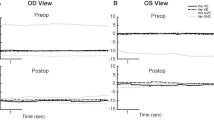Abstract
Strabismus is a common clinical condition in which the visual axes of the eyes do not intersect on the object being viewed1. As such, the ability to achieve single binocular vision by fusing the images of a single object in the two eyes is lost. In most cases of strabismus, one of the two eyes is clearly deviated and the other eye is used for fixation, although in some cases each eye is used alternately for fixation2,3. While much attention has been devoted to the motor capabilities of the deviating eye in strabismus1–3, little attention has been given to the visuomotor competence of the other eye. We report here that, if one eye of a kitten is made to deviate by surgery, the visuomotor capacities of the other, ‘normal’, eye are affected. A reduction in the ability to follow the movement of a large striped drum is observed with binocular viewing, even when stimuli are viewed monocularly with the normal eye. This means that anomalous visual input from the deviated eye during stimulation is not the cause of the reduced oculomotor capacities.
This is a preview of subscription content, access via your institution
Access options
Subscribe to this journal
Receive 51 print issues and online access
$199.00 per year
only $3.90 per issue
Buy this article
- Purchase on Springer Link
- Instant access to full article PDF
Prices may be subject to local taxes which are calculated during checkout
Similar content being viewed by others
References
Alpern, M. & Davson, H. eds The Eye Vol. 3, 1–127 (Academic, London, 1969).
Burian, H. M. & Von Noorden, G. K. Binocular Vision and Ocular Motility (C. V. Mosby, St Louis, 1974).
Duke, Elder, S. & Wybar, K. in System of Ophthalmology Vol. 6 (C. V Mosby St Louis, 1973).
Robinson, D. A. IEEE, Trans. Biomed. Electron. BME-10, 137–145 (1963).
Harris, L. R. & Cynader, M. Invest. Ophthalm. 18, suppl. 263 (1979).
Ter Braak, J. W. G. Arch neerl. Physiol. 21, 309–376 (1936).
Cohen, B. Handbook of Sensory Physiology: Vestibular System Vol. 6, Part 1 (ed. Kornhuber, H.) 477–540 (Springer Berlin, 1973).
Honrubia, V., Ward, P. H. & Scott, W. Acta otolaryng 64, 388–402 (1967).
Hubel, D. H. & Wiesel, T. N. J. Neurophysiol. 28, 1041–1059 (1965).
Cynader, M., Mustari, M. & Gardner, J. G. Soc. Neurosci. Symp. 4, 99–120 (1979).
Cynader, M. & Hoffmann, K. P. (in preparation).
Collewijn, H. J. J. Neurobiol. 6, 3–21 (1975).
Hoffmann, K. P. Brain Res. 99, 359–366 (1975).
Schor, C. M. & Levi, D. Invest. Ophthalm. 18, suppl. 201 (1979).
Crone, R. A. Docum. Ophthalm. 45, 9–18 (1977).
Hering, E. The Theory of Binocular Vision (eds Bridgeman, B. & Stark, L.) 17–46 (Plenum, New York, 1977).
Author information
Authors and Affiliations
Rights and permissions
About this article
Cite this article
Cynader, M., Harris, L. Eye movement in strabismic cats. Nature 286, 64–65 (1980). https://doi.org/10.1038/286064a0
Received:
Accepted:
Issue Date:
DOI: https://doi.org/10.1038/286064a0
This article is cited by
-
Effects of Divergent Strabismus on the Horizontal Connections of Neurons in the Cat Visual Cortex
Neuroscience and Behavioral Physiology (2010)
-
The relationship between infantile strabismus and latent nystagmus
Eye (1996)
Comments
By submitting a comment you agree to abide by our Terms and Community Guidelines. If you find something abusive or that does not comply with our terms or guidelines please flag it as inappropriate.



